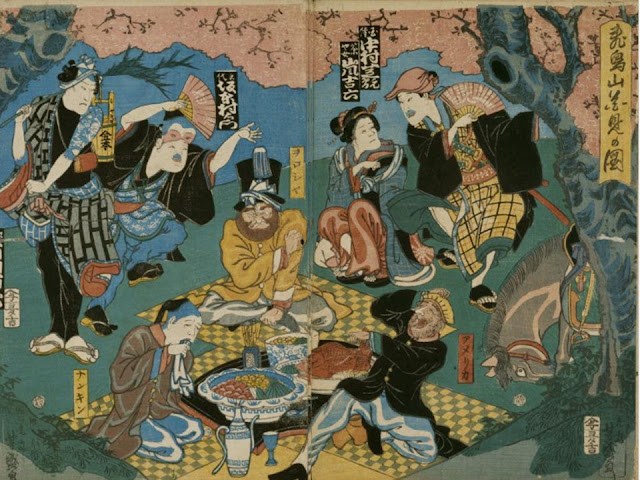Asukayama in Tokyo is famous for sakura (cherry blossoms). The 8th generation shogun “Tokugawa Yoshimune” developed the hill as a sakura park and opened to the public. The shogun’s idea brought the enjoyable place to people. I submitted an application form in order to take photos when I visited.
東京の桜の名所・飛鳥山にある博物館です。飛鳥山は、八代将軍・徳川吉宗が遊園として開発し、桜を植え、庶民に開放しました。知りませんでした。当時は公園という概念がない時代。寛永寺の境内だった上野と違い、無礼講で楽しめる場所でした。明治6(1873)年、公園が制定されると、第一号公園の一つとなりました。吉宗の計らいが、人々に多くの楽しみをもたらしました。訪問時に、写真撮影の申請書を提出しました。
The section above is about the Edo period (1603~1868). There is a sakura tree and bento lunchboxes in center.
まずは、江戸時代から紹介します。中央に桜、その下にお弁当が展示されています。
The history of Asukayama is shown here. The shogun loved the hill because it is related to his home town (Wakayama prefecture in western Japan). He planted 270 of sakura trees in 1720, and did 1000 ones next year. He permitted to build ten tea houses and opened the hill to the public in 1733. The shogun confiscated the hill from the owner, and held a sakura viewing party, then donated the hill to Kinrinji (temple).
You may think he was a tyrant. The hill was managed by the shogun, so people hesitated to go there. Therefore, he held a cheerful party and invited people and monks. His retainers dressed up and accompanied him. Thereafter, people didn't hesitate to go there. The party was held by his cool idea. In 1738, fifty-four tea houses were in operation.
It is written that visiting a rural tourist spot, seeing sakura blossoms, singing, dancing and eating lunch were popular recreation among people back then. The hill is just 8 km away from the heart of Edo (old name of Tokyo) and there is also a river. The area became a popular destination for one-day trip.
吉宗は、出身地である紀伊国飛鳥明神と縁深い飛鳥山に愛着を持ち、1720年に桜を270本、翌年に1000本を植えました。水茶屋10軒を許可し、1733年に一般公開しました。1737年には地主から土地を召し上げ、花見の宴を開き、土地を金輪寺に寄付しました。
ちょっとひどい気もしますが、飛鳥山は御用地だったので、花見に来る人はいませんでした。そこで、将軍がお手本となって盛大な宴を催したのでした。家臣には仮装させ、村人や僧侶も招きました。その後、飛鳥山は万人が気兼ねなく遊べる場所になりました。粋な計らいですね。1738年には水茶屋54軒などの営業が許可されました。
「江戸時代、郊外の名所を訪れ、花を見て歌いおどり食事を楽しむことは、人々のあいだで盛んに行われた娯楽でした」と書かれています。飛鳥山は、日本橋から8km、滝野川もあり江戸市中から日帰り可能な人気行楽地になりました。
The exhibits of bento lunchboxes during sakura viewing are perfect, which are based on a book published in 1801. There are three of its kind; they ate good foods!
The photo above is the highest-class bento, which has sashimi (raw fish). Those are high-level banquet dishes, I can say.
花見弁当(重箱)の展示が秀逸です。1801年に発行された「料理早指南」に記載されている「花見の提げ重詰」の上、中、下を再現しています。いい物を食べていますよ。
まずは、上の部。ヒラメやサヨリの刺身もあります。宴会料理のレベルです。
The photo above is a middle-class bento, and the one below is a normal one. Even in the normal one, there are sweet mochi cakes and grilled rice balls in it. Those were very special delicacies back then.
上の写真が中の部、下の写真が下の部のお重です。うぐいす餅や焼きおにぎりも入っていて、なかなかのご馳走です。
There are many pictures about sakura viewing in Asukayama. The cat in the shogun’s room says “By the order of the shogun, you must not get on the stage”.
花見の絵もたくさん残っています。金輪寺(きんりんじ)の御座所を再現した部屋に置いてある猫の前には、「上様よりのお達し ここに入るべからず」と書いてあります。
It’s Fuji-kou (religious group) section. It was popular in Tokyo in the Edo period. Fuji-kou says the importance of cooperation regardless of gender, so it’s popular. The photo at the lower left is talismans of it.
こちらは富士講の展示です。都内の博物館では富士講の展示が多く、「江戸八百八講」といわれたほど、富士講が多かったことが分かります。富士講は、性別にかかわらず助け合うことを説いたので、庶民の関心を集めました。左下は、御札などです。
The theme of the section is “Prayer in the medieval era”. The sea route to Wakayama was improved and people went there which is around 600km away. So, visiting Kumano Shrine in Wakayama spread. The shogun whose home town was Wakayama became familiar with Asukayama. All things were linked.
中世の祈りと願い。紀伊国との海上交通が盛んになった鎌倉時代、熊野詣では庶民にも広がりました。ビックリ。御師が信仰を広めました。豪族の豊島氏は、熊野権現の御子神(みこがみ)を祀りました。そして、紀伊国出身の吉宗はこの地を気に入りました。当地と紀伊国の繋がりは強いですね。
Dengaku event has started in the medieval era. They pray for good harvest. They have special outfits.
中世に始まった王子田楽は今も行われています。豊作を祈ります。独特の装束です(12番/子魔帰/こまがえし、右上)。
It was depicted in the book which was published in 1813. The attractive event made many people note it.
1813年に出された「見田楽記」(複製)です。仮装して踊る王子田楽は、様々な人が記録を残しました。見て楽しめる行事だったのですね。
The ancient section is also interesting.
Three things I learn are,
1. “Kaizuka” (shell midden) wasn’t a garbage dump. It was a place where used things were buried, and people appreciated them. Even human bodies were buried in it.
2. Shell fishes were dried and were delivered to inner areas. The possible primitive factory was found.
3. Beans were probably cultivated back then.
It was before the rice farming era and it is said that there was no war at that time.
縄文時代の展示では、
①貝塚からは人骨も出土することがあります。「使命を終えたものを偲び、・・・一箇所に集めた“送りの場”だと考えられます。貝塚は現代人の考えるようなゴミ捨て場ではないのです」と書かれています。
②中里貝塚では集落の消費量をはるかに超える貝が見つかりました。いくつかの集落が共同で干し貝にし、内陸の村に売っていたと考えられるそうです。「巨大な貝の加工場」と書かれています。
③大豆を栽培されていた可能性があるそうです。
貝を葬るということも、狩猟だけでなく、栽培や加工をしていたことも、知りませんでした。稲作を始まる前の縄文時代は、戦いが無かった時代といわれています。
The house above is a model in the Yayoi period (around two thousand years ago) when we started rice planting. They had rich ingredient, but those were not served at once, I think.
弥生時代の家と食事。一度に出された訳ではないのでしょうが、食材が豊富です。
It’s before a sakura season; it was a peaceful park.
桜はまだですが、もうすぐ賑やかになります。今はのどかな園地です。
Appendix、付録
Hnami party in the Edo period. The drunk man turned over the lunchbox, but I think he felt happy.
江戸名所道戯尽 五 飛鳥山の花見。せっかくのお重も銚子もひっくり返っています。飛鳥山からは富士山も筑波山も見えました。
https://dl.ndl.go.jp/info:ndljp/pid/1308266 国立国会図書館デジタルコレクション
https://dl.ndl.go.jp/info:ndljp/pid/1310508?tocOpened=1
国立国会図書館デジタルコレクション
Visited in May, 2022
Official website: https://www.city.kita.tokyo.jp/hakubutsukan/
(in Japanese), accessed in March, 2023
Previous post (museum at sakura viewing spot in Tokyo): Sumida Heritage Museum、すみだ郷土文化資料館
Next post (museum in Tokyo): Adachi City Museum、足立区立郷土博物館

















Comments
Post a Comment